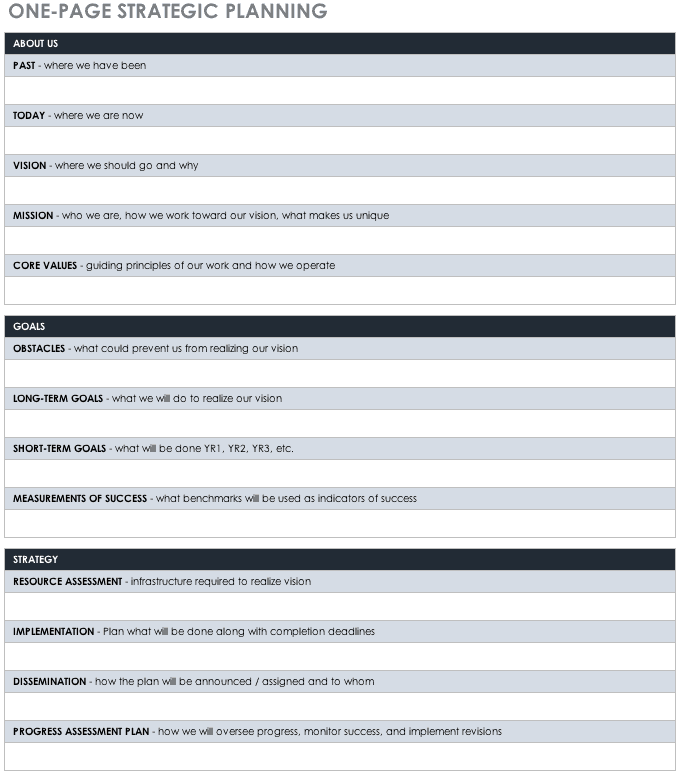What Is Strategic Planning?
Strategic planning is an organizational activity that aims to achieve a group’s goals. The process helps define a company’s objectives and investigates both internal and external happenings that might influence the organizational path. Strategic planning also helps identify adjustments that you might need to make to reach your goal. Strategic planning became popular in the 1960s because it helped companies set priorities and goals, strengthen operations, and establish agreement among managers about outcomes and results.
Strategic planning can occur over multiple years, and the process can vary in length, as can the final plan itself. Ideally, strategic planning should result in a document, a presentation, or a report that sets out a blueprint for the company’s progress.
By setting priorities, companies help ensure employees are working toward common and defined goals. It also aids in defining the direction an enterprise is heading, efficiently using resources to achieve the organization’s goals and objectives. Based on the plan, managers can make decisions or allocate the resources necessary to pursue the strategy and minimize risks.
Strategic planning strengthens operations by getting input from people with differing opinions and building a consensus about the company’s direction. Along with focusing energy and resources, the strategic planning process allows people to develop a sense of ownership in the product they create.
What Strategic Planning Is Not
Strategic planning is not a to-do list for the short or long term — it is the basis of a business, its direction, and how it will get there.
“You have to think very strategically about strategic planning. It is more than just following steps,” Bryson explains. “You have to understand strategic planning is not some kind of magic solution to fixing issues. Don’t have unrealistic expectations.”
Strategic planning is also different from a business plan that focuses on a specific product, service, or program and short-term goals. Rather, strategic planning means looking at the big picture.
While they are related, it is important not to confuse strategic planning with strategic thinking, which is more about imagining and innovating in a way that helps a company. In contrast, strategic planning supports those thoughts and helps you figure out how to make them a reality.
Another part of strategic planning is tactical planning, which involves looking at short-term efforts to achieve longer-term goals.
Lastly, marketing plans are not the same as strategic plans. A marketing plan is more about introducing and delivering a service or product to the public instead of how to grow a business. For more about marketing plans and processes, read this article.
Strategic plans include information about finances, but they are different from financial planning, which involves different processes and people. Financial planning templates can help with that process.
Why Is Strategic Planning Important?
In today’s technological age, strategic plans provide businesses with a path forward. Strategic plans help companies thrive, not just survive — they provide a clear focus, which makes an organization more efficient and effective, thereby increasing productivity.
Getting team members on the same page (in both creating a strategic plan and executing the plan itself) can be beneficial for a company. Planners can find satisfaction in the process and unite around a common vision. In addition, you can build strong teams and bridge gaps between staff and management.
“You have to reach agreement about good ideas,” Bryson says. “A really good strategy has to meet a lot of criteria. It has to be technically workable, administratively feasible, politically acceptable, and legally, morally, and ethically defensible, and that is a pretty tough list.”
By discussing a company’s issues during the planning process, individuals can voice their opinions and provide information necessary to move the organization ahead — a form of problem solving as a group.
Strategic plans also provide a mechanism to measure success and progress toward goals, which keeps employees on the same page and helps them focus on the tasks at hand.
When Is the Time to Do Strategic Planning?
There is no perfect time to perform strategic planning. It depends entirely on the organization and the external environment that surrounds it. However, here are some suggestions about when to plan:
-
If your industry is changing rapidly
-
When an organization is launching
-
At the start of a new year or funding period
-
In preparation for a major new initiative
-
If regulations and laws in your industry are or will be changing
“It’s not like you do all of the thinking and planning, and then implement,” Bryson says. “A mistake people make is [believing] the thinking has to precede the acting and the learning.”
Even if you do not re-create the entire planning process often, it is important to periodically check your plan and make sure it is still working. If not, update it.
What Is the Strategic Planning Process?
Strategic planning is a process, and not an easy one. A key is to make sure you allow enough time to complete the process without rushing, but not take so much time that you lose momentum and focus. The process itself can be more important than the final document due to the information that comes out of the discussions with management, as well as lower-level workers.
Level 1 is the Strategic Planning Professional (SPP) certification. It is designed for early- or mid-career planners who work in strategic planning. Level 2, the Strategic Management Professional (SMP) certification, is geared toward seasoned professionals or those who train others. Stockmal explains that ASP designed the certification programs to add structure to the otherwise amorphous profession.
The strategic planning process varies by the size of the organization and can be formal or informal, but there are constraints. For example, teams of all sizes and goals should build in many points along the way for feedback from key leaders — this helps the process stay on track.
Some elements of the process might have specific start and end points, while others are continuous. For example, there might not be one “aha” moment that suddenly makes things clear. Instead, a series of small moves could slowly shift the organization in the right direction.
“Don’t make it overly complex. Bring all of the stakeholders together for input and feedback,” Stockmal advises. “Always be doing a continuous environmental scan, and don’t be afraid to engage with stakeholders.”
Additionally, knowing your company culture is important. “You need to make it work for your organization,” he says.
There are many different ways to approach the strategic planning process. Below are three popular approaches:
-
Goals-Based Planning: This approach begins by looking at an organization’s mission and goals. From there, you work toward that mission, implement strategies necessary to achieve those goals, and assign roles and deadlines for reaching certain milestones.
-
Issues-Based Planning: In this approach, start by looking at issues the company is facing, then decide how to address them and what actions to take.
-
Organic Planning: This approach is more fluid and begins with defining mission and values, then outlining plans to achieve that vision while sticking to the values.
“The approach to strategic planning needs to be contingent upon the organization, its history, what it’s capable of doing, etc.,” Bryson explains. “There’s such a mistake to think there’s one approach.”
For more information on strategic planning, read about how to write a strategic plan and the different types of models you can use.
Who Participates in the Strategic Planning Process?
For work as crucial as strategic planning, it is necessary to get the right team together and include them from the beginning of the process. Try to include as many stakeholders as you can.
Below are suggestions on who to include:
-
Senior leadership
-
Strategic planners
-
Strategists
-
People who will be responsible for implementing the plan
-
People to identify gaps in the plan
-
Members of the board of directors
“There can be magic to strategic planning, but it’s not in any specific framework or anybody’s 10-step process,” Bryson explains. “The magic is getting key people together, getting them to focus on what’s important, and [getting] them to do something about it. That’s where the magic is.”
Hofmeyer recommends finding people within an organization who are not necessarily current leaders, but may be in the future. “Sometimes they just become obvious. Usually they show themselves to you, you don’t need to look for them. They’re motivated to participate,” he says. These future leaders are the ones who speak up at meetings or on other occasions, who put themselves out there even though it is not part of their job description.
At the beginning of the process, establish guidelines about who will be involved and what will be expected of them. Everyone involved must be willing to cooperate and collaborate. If there is a question about whether or not to include anyone, it is usually better to bring on extra people than to leave someone out, only to discover later they should have been a part of the process all along. Not everyone will be involved the entire time; people will come and go during different phases.
Often, an outside facilitator or consultant can be an asset to a strategic planning committee. It is sometimes difficult for managers and other employees to sit back and discuss what they need to accomplish as a company and how they need to do it without considering other factors. As objective observers, outside help can often offer insight that may escape insiders.
Hofmeyer says sometimes bosses have blinders on that keep them from seeing what is happening around them, which allows them to ignore potential conflicts. “People often have their own agendas of where they want to go, and if they are not aligned, it is difficult to build a strategic plan. An outsider perspective can really take you out of your bubble and tell you things you don’t necessarily want to hear [but should]. We get into a rhythm, and it’s really hard to step out of that, so bringing in outside people can help bring in new views and aspects of your business.”
An outside consultant can also help naysayers take the process more seriously because they know the company is investing money in the efforts, Hofmeyer adds.
No matter who is involved in the planning process, make sure at least one person serves as an administrator and documents all planning committee actions.
What Is in a Strategic Plan?
A strategic plan communicates goals and what it takes to achieve them. The plan sometimes begins with a high-level view, then becomes more specific. Since strategic plans are more guidebooks than rulebooks, they don’t have to be bureaucratic and rigid. There is no perfect plan; however, it needs to be realistic.
There are many sections in a strategic plan, and the length of the final document or presentation will vary. The names people use for the sections differ, but the general ideas behind them are similar: Simply make sure you and your team agree on the terms you will use and what each means.
One-Page Strategic Planning Template
“I’m a big fan of getting a strategy onto one sheet of paper. It’s a strategic plan in a nutshell, and it provides a clear line of sight,” Stockmal advises.
You can use the template below to consolidate all your strategic ideas into a succinct, one-page strategic plan. Doing so provides you with a high-level overview of your strategic initiatives that you can place on your website, distribute to stakeholders, and refer to internally. More extensive details about implementation, capacity, and other concerns can go into an expanded document.
Download One-Page Strategic Planning Template
Excel | Word | Smartsheet
The most important part of the strategic plan is the executive summary, which contains the highlights of the plan. Although it appears at the beginning of the plan, it should be written last, after you have done all your research.
Of writing the executive summary, Stockmal says, “I find it much easier to extract and cut and edit than to do it first.”
For help with creating executive summaries, see these templates.
Other parts of a strategic plan can include the following:
-
Description: A description of the company or organization.
-
Vision Statement: A bold or inspirational statement about where you want your company to be in the future.
-
Mission Statement: In this section, describe what you do today, your audience, and your approach as you work toward your vision.
-
Core Values: In this section, list the beliefs and behaviors that will enable you to achieve your mission and, eventually, your vision.
-
Goals: Provide a few statements of how you will achieve your vision over the long term.
-
Objectives: Each long-term goal should have a few one-year objectives that advance the plan. Make objectives SMART (specific, measurable, achievable, and time-based) to get the most out of them.
-
Budget and Operating Plans: Highlight resources you will need and how you will implement them.
-
Monitoring and Evaluation: In this section, describe how you will check your progress and determine when you achieve your goals.
One of the first steps in creating a strategic plan is to perform both an internal and external analysis of the company’s environment. Internally, look at your company’s strengths and weaknesses, as well as the personal values of those who will implement your plan (managers, executives, board members). Externally, examine threats and opportunities within the industry and any broad societal expectations that might exist.
You can perform a SWOT (strengths, weaknesses, opportunities, and threats) analysis to sum up where you are currently and what you should focus on to help you achieve your future goals. Strengths shows you what you do well, weaknesses point out obstacles that could keep you from achieving your objectives, opportunities highlight where you can grow, and threats pinpoint external factors that could be obstacles in your way.
You can find more information about performing a SWOT analysis and free templates in this article. Another analysis technique, STEEPLE (social, technological, economic, environmental, political, legal, and ethical), often accompanies a SWOT analysis.
Basics of Strategic Planning
How you navigate the strategic planning process will vary. Several tools and techniques are available, and your choice depends on your company’s leadership, culture, environment, and size, as well as the expertise of the planners.
All include similar sections in the final plan, but the ways of driving those results differ. Some tools are goals-based, while others are issues- or scenario-based. Some rely on a more organic or rigid process.
Hofmeyer summarizes what goes into strategic planning:
-
Understand the stakeholders and involve them from the beginning.
-
Agree on a vision.
-
Hold successful meetings and sessions.
-
Summarize and present the plan to stakeholders.
-
Identify and check metrics.
-
Make periodic adjustments.
Items That Go into Strategic Planning
Strategic planning contains inputs, activities, outputs, and outcomes. Inputs and activities are elements that are internal to the company, while outputs and outcomes are external.
Remember, there are many different names for the sections of strategic plans. The key is to agree what terms you will use and define them for everyone involved.
Inputs
Inputs are important because it is impossible to know where you are going until you know what is around you where you are now.
Companies need to gather data from a variety of sources to get a clear look at the competitive environment and the opportunities and risks within that environment. You can think of it like a competitive intelligence program.
Data should come from the following sources:
-
Interviews with executives
-
A review of documents about the competition or market that are publicly available
-
Primary research by visiting or observing competitors
-
Studies of your industry
-
The values of key stakeholders
This information often goes into writing an organization’s vision and mission statements.
Activities
Activities are the meetings and other communications that need to happen during the strategic planning process to help everyone understand the competition that surrounds the organization.
It is important both to understand the competitive environment and your company’s response to it. This is where everyone looks at and responds to the data gathered from the inputs.
Outputs
The strategic planning process produces outputs. Outputs can be as basic as the strategic planning document itself. The documentation and communications that describe your organization’s strategy, as well as financial statements and budgets, can also be outputs.
Outcomes
The implementation of the strategic plan produces outcomes (distinct from outputs). The outcomes determine the success or failure of the strategic plan by measuring how close they are to the goals and vision you outline in your plan.
It is important to understand there will be unplanned and unintended outcomes, too. How you learn from and adapt to these changes influence the success of the strategic plan.
During the planning process, decide how you will measure both the successes and failures of different parts of the strategic plan.
Sharing, Evaluating, and Monitoring the Progress of a Strategic Plan
After companies go through a lengthy strategic planning process, it is important that the plan does not sit and collect dust. Share, evaluate, and monitor the plan to assess how you are doing and make any necessary updates.
“[Some] leaders think that once they have their strategy, it’s up to someone else to execute it. That’s a mistake I see,” Stockmal says.
The process begins with distributing and communicating the plan. Decide who will get a copy of the plan and how those people will tell others about it. Will you have a meeting to kick off the implementation? How will you specify who will do what and when? Clearly communicate the roles people will have.
“Before you communicate the plan [to everyone], you need to have the commitment of stakeholders,” Hofmeyer recommends. Have the stakeholders be a part of announcing the plan to everyone — this keeps them accountable because workers will associate them with the strategy. “That applies pressure to the stakeholders to actually do the work.”
Once the team begins implementation, it’s necessary to have benchmarks to help measure your successes against the plan’s objectives. Sometimes, having smaller action plans within the larger plan can help keep the work on track.
During the planning process, you should have decided how you will measure success. Now, figure out how and when you will document progress. Keep an eye out for gaps between the vision and its implementation — a big gap could be a sign that you are deviating from the plan.
Tools are available to assist with tracking performance of strategic plans, including several types of software. “For some organizations, a spreadsheet is enough, but you are going to manually enter the data, so someone needs to be responsible for that,” Stockmal recommends.
Remember: strategic plans are not written in stone. Some deviation will be necessary, and when it happens, it’s important to understand why it occurred and how the change might impact the company's vision and goals.
Deviation from the plan does not mean failure, reminds Hofmeyer. Instead, understanding what transpired is the key. “Things happen, [and] you should always be on the lookout for that. I’m a firm believer in continuous improvement,” he says. Explain to stakeholders why a change is taking place. “There’s always a sense of re-evaluation, but do it methodically.”
Build in a schedule to review and amend the plan as necessary; this can help keep companies on track.
What Is Strategic Management?
Strategic planning is part of strategic management, and it involves the activities that make the strategic plan a reality. Essentially, strategic management is getting from the starting point to the goal effectively and efficiently using the ongoing activities and processes that a company takes on in order to keep in line with its mission, vision, and strategic plan.
“[Strategic management] closes the gap between the plan and executing the strategy,” Stockmal of ASP says. Strategic management is part of a larger planning process that includes budgeting, forecasting, capital allocation, and more.
There is no right or wrong way to do strategic management — only guidelines. The basic phases are preparing for strategic planning, creating the strategic plan, and implementing that plan.
No matter how you manage your plan, it’s key to allow the strategic plan to evolve and grow as necessary, due to both the internal and external factors.
“We get caught up in all of the day-to-day issues,” Stockmal explains, adding that people do not often leave enough time for implementing the plan and making progress. That’s what strategic management implores: doing things that are in the plan and not letting the plan sit on a shelf.
Improve Strategic Planning with Real-Time Work Management in Smartsheet
Empower your people to go above and beyond with a flexible platform designed to match the needs of your team — and adapt as those needs change.
The Smartsheet platform makes it easy to plan, capture, manage, and report on work from anywhere, helping your team be more effective and get more done. Report on key metrics and get real-time visibility into work as it happens with roll-up reports, dashboards, and automated workflows built to keep your team connected and informed.
When teams have clarity into the work getting done, there’s no telling how much more they can accomplish in the same amount of time. Try Smartsheet for free, today.



